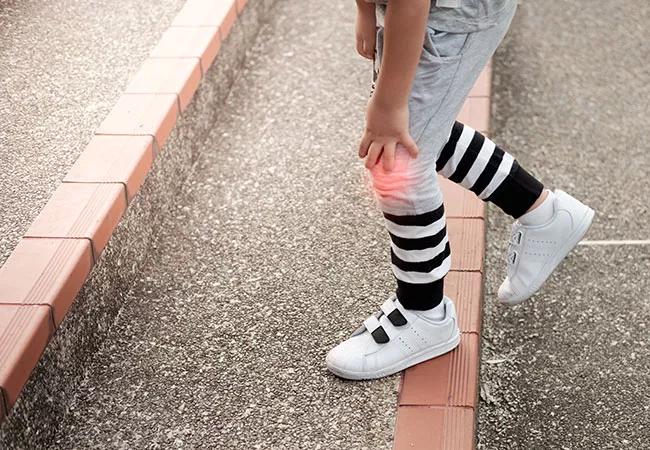May compound physical, psychological and social dysfunction

A 17-year-old girl with amplified musculoskeletal pain syndrome, headaches and chronic abdominal pain was referred to the Pediatric Pain Rehabilitation Program at Cleveland Clinic Children’s Hospital for Rehabilitation. She considered herself uncoordinated and weak, and had difficulty keeping up with her peers’ physical abilities. She disliked athletic activities, particularly performing in front of others. She preferred isolated, sedentary pastimes and avoided school and social events.
Advertisement
Cleveland Clinic is a non-profit academic medical center. Advertising on our site helps support our mission. We do not endorse non-Cleveland Clinic products or services. Policy
A 14-year-old boy presented with the same pain conditions. While he claimed to be a star soccer goalie, his physical and occupational therapists noted a deficiency in motor planning, running with proper mechanics and performing other sport-related movements. He avoided school and social activities (other than soccer) and isolated himself from peers.
When challenged with new or more difficult physical tasks during their rehabilitation program, both patients had more pain complaints, less engagement and poorer overall function.
Cases like these are quite common, says Heidi Kempert, PTA, of Cleveland Clinic’s Pediatric Pain Rehabilitation Program. Kids with chronic pain often demonstrate motor-planning and coordination difficulties, she says.
“We’re not sure if the coordination deficiency contributes to the pain or vice versa,” says Kempert. “Regardless, the compound problem increases their psychological stress and interferes with their ability to participate in rehabilitation and eventually resume normal functioning.”
Physical, psychological and social manifestations of chronic pain and developmental coordination disorder (DCD) are strikingly similar and likely interrelated, notes Kempert. She and colleagues Rachel Heines, DPT, and Lauren Nelson, MS, OTR/L, recently published a commentary on the topic in Pediatric Pain Letter.
“The incidence of coordination difficulties may not be higher in adolescents with chronic pain compared to a general, age-matched population, but coordination impacts the daily life of chronic pain patients more than kids without chronic pain,” says Heines.
Advertisement
Being uncoordinated shouldn’t be shrugged off as an adolescent’s natural tendency, she says. There can be significant repercussions, especially when lack of coordination is due to a neurological condition like DCD.
For example, research shows that people with DCD are at higher risk for social, emotional, psychiatric, academic and professional problems during their lifetime. People with DCD also are more prone to acute injuries, which can exacerbate pain conditions.
The long-term outlook for people with DCD alone isn’t great, says Kempert, but it’s even worse when you add a chronic pain condition.
“DCD continues into adulthood more than 50% of the time,” she says. “We may be able to prevent some lifelong challenges if we address coordination issues in adolescence.”
Diagnosing coordination deficits isn’t always straightforward. Deficiencies can be difficult to identify and categorize.
Most standardized coordination assessments are designed for kids with severe impairments, explains Nelson. That’s why some kids in pain rehabilitation do well on the assessments, yet still have a coordination deficiency detected by their physical or occupational therapist.
“A patient may be able to successfully complete an assessment that requires jumping jacks, skipping and standing on one leg,” says Nelson. “But in our program, we’re throwing and catching balls, doing bilateral coordination exercises and performing body awareness activities like recreating a posture or movement in a picture. That’s when we may notice a deficiency.”
Advertisement
At Cleveland Clinic Children’s Hospital for Rehabilitation, therapists focus on improving function (e.g., attending school, being out in the community, socializing with friends, performing physical activity) as the first step in treating pain. They work to improve patients’ awareness of:
“We need patients to understand basic alignment, joint conservation, use of energy and behaviors that make physical movement more challenging and painful,” says Kempert. “This is why it is important to adjust when kids also have coordination and motor-planning difficulties. They make this key part of treatment more difficult.”
Whenever a patient lacks coordination to complete a physical task, therapists slow down the action and break it into individual components.
“For example, to help a patient set a volleyball, we’ll first practice foot movements, then practice hand and arm movements, then put them together without the ball, then add the ball and speed up the task,” says Heines.
Helping the patient build strength and muscle endurance to complete the task is another factor.
Pediatricians are typically the first stop for adolescents who struggle with chronic pain. While pain can be difficult to quantify, pediatricians can gauge severity by assessing the pain’s impact on the patient’s quality of life. Inquiring about participation in school and family life, involvement in physical activity and interest in social events helps pediatricians get a holistic view.
Advertisement
“If a child says she hasn’t been going to school, but lies in bed 18 hours a day and eats junk food, that indicates where a pediatrician can begin to address the pain complaints,” says Kempert. “Chronic pain often improves when a child is physically active, socially engaged and has proper nutrition.”
A chronic pain patient’s initial treatment plan should include physical therapy, occupational therapy and psychology, she adds — even before referring the patient to rheumatology, neurology or other specialties.
“Early intervention is critical in managing chronic pain, especially when compounded by coordination deficits,” says Kempert. “Taking action right away can help many kids prevent the physical, psychological and social issues that decrease their functioning long term.”
Advertisement
Advertisement

Integrated care model reduces length of stay, improves outpatient pain management

A closer look at the impact on procedures and patient outcomes

Experts advise thorough assessment of right ventricle and reinforcement of tricuspid valve

Study also finds that 26% of children with cancer have mutations in DNA repair genes

A closer look at current uses and future opportunities

Experts are challenging the one-size-fits-all paradigm

Quality improvement project addresses unplanned extubation

Cardiac imaging substudy is the latest paper originating from the VANISH trial